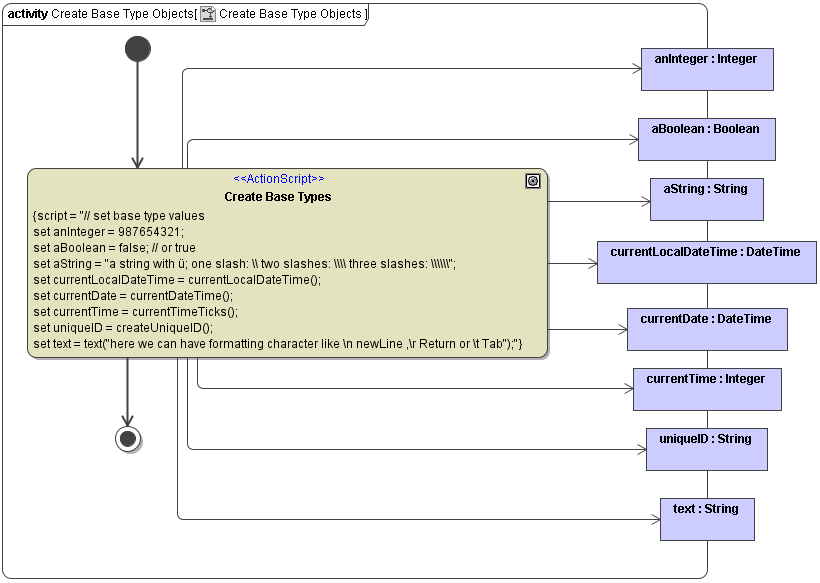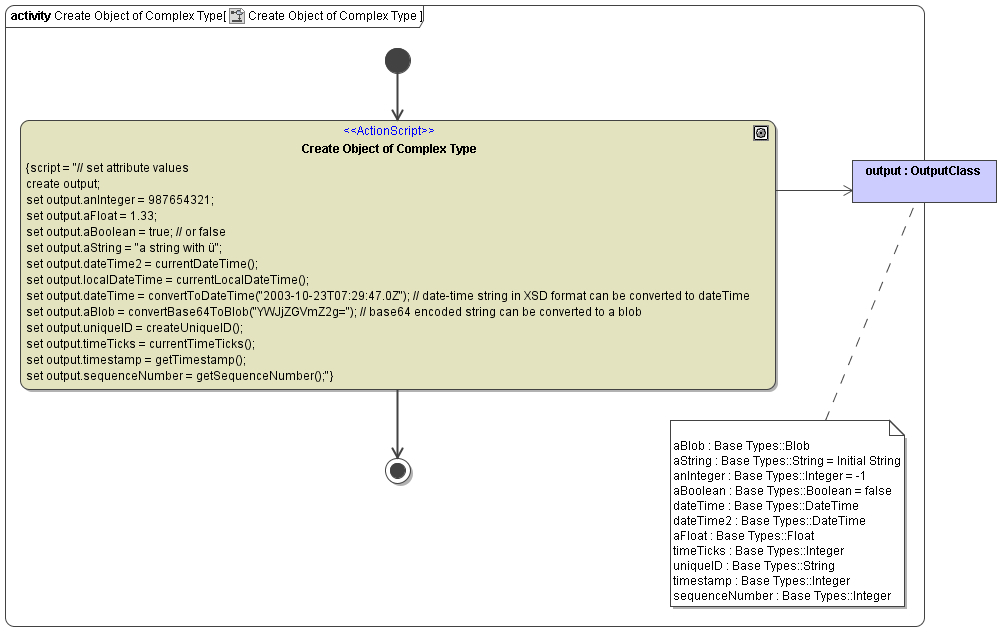Versions Compared
Key
- This line was added.
- This line was removed.
- Formatting was changed.
| Div | ||||||
|---|---|---|---|---|---|---|
| ||||||
|
The most basic feature of each language is creating instances of classes and setting values. With the set assignment statement, it is possible to create objects of base types like strings, integers, booleans, etc. whereas objects of complex types need to be instantiated (created) first with the create statement.
If you define an output object node having a complex type (opposed to base types like String, Integer, etc.), it needs to be created first. In object-oriented terminology: class objects need to be instantiated (that is creating an instance of the corresponding class). Once the instance of the class (the object) has been created, it can store data in its attributes.
Creating Base Types with the set Assignment Statement
The following examples shows how to use the set assignment statement to create base type objects.
Multiexcerpt include MultiExcerptName objectCreation nopanel true PageWithExcerpt INTERNAL:_examples_BRIDGE
...
| Syntax |
| ||||||
|---|---|---|---|---|---|---|---|
| Semantics | Assigns a value to anObject. | ||||||
| Substitutables | anObject | Can be an object node, an attribute, or an association end. | |||||
aValue | Can be a literal, a base type object node, or an EAL operation or expression returning a base type. | ||||||
| Examples |
| ||||||
The example in the figure below shows how to create base type objects like strings, integers, etc. Base type objects need not to be instantiated, they are created by using the set assignment statement to directly assign a value to the variable.
All variables are drawn as object nodes with all objects being of base type (see also Base Types).
Figure: Creating Base Type Objects Anchor Creating Base Type Objects Creating Base Type Objects
 Image Modified
Image Modified
Attributes of an object are also assigned values by using the set assignment statement as shown in the figure below.
Figure: Setting Attribute Values
 Image Modified
Image Modified
Creating Arrays by Appending Items
| Multiexcerpt include | ||||
|---|---|---|---|---|
|
Creating Objects of Complex Type
The following example shows how to use the create statement to create objects of complex type.
Multiexcerpt include MultiExcerptName objectCreation nopanel true PageWithExcerpt INTERNAL:_examples_BRIDGE
| Syntax |
| ||||||
|---|---|---|---|---|---|---|---|
| Semantics | Creates an object of complex type. The object reference is stored in anObject. Initial values defined on the class attributes will be set. | ||||||
| Substitutables | anObject | Can be any valid object name. | |||||
| Examples |
| ||||||
In the following cases, objects need to be created with the create statement:
- Creating an object (creating an instance of a class).
- Result objects of an iteration over an action script need to be created (compare section Iterate Over Action Scripts).
In the following cases, the create statement is not necessary:
- Adapters may create objects of any type. Those objects need not to be created explicitly (for instance, an object that is created after an SQL query executed by the SQL adapter).
When having related classes, the instantiation of intermediate objects is not mandatory. In the example below, class A has an attribute b, which is of type B (see association). This class in turn has a string attribute named aString.
Figure: Creating Instances of Related Classes
 Image Modified
Image Modified
In order to instantiate all classes and setting the string aString, not all class instances need to be created. Only the top-level class needs to instantiated as shown in the following action script:Code Block create objectOfClassA; set objectOfClassA.b.aString ="Hello World!";
| Note | ||
|---|---|---|
| ||
Scalar base type objects are never created using the |
| Panel | ||
|---|---|---|
| ||
|
| Panel | ||
|---|---|---|
| ||